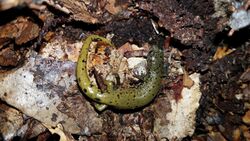Biology:Pseudoeurycea lynchi
| Pseudoeurycea lynchi | |
|---|---|

| |
| Scientific classification | |
| Domain: | Eukaryota |
| Kingdom: | Animalia |
| Phylum: | Chordata |
| Class: | Amphibia |
| Order: | Urodela |
| Family: | Plethodontidae |
| Genus: | Pseudoeurycea |
| Species: | P. lynchi
|
| Binomial name | |
| Pseudoeurycea lynchi Parra-Olea, Papenfuss, and Wake, 2001[2]
| |
Pseudoeurycea lynchi, commonly known as the Veracruz green salamander, is a species of salamanders in the family Plethodontidae. It is endemic to the central Sierra Madre Oriental in Veracruz and Puebla states, Mexico. [3]
Etymology
The specific name lynchi honors Dr. James Francis Lynch (1942–1988), a "friend and long-time collaborator".[2] (Not John D. Lynch as sometimes claimed.[4])
Description
Adult males measure 41–48 mm (1.6–1.9 in) and females 41–54 mm (1.6–2.1 in) in snout–vent length (SVL). The tail is relatively stout, tapering rather abruptly toward the tip, and is about the same length as the SVL (range 86–115 %). The hands and feet are comparatively well developed. The coloration of the dorsum is variable: dark green, green-ochre, pale yellow-green, tannish yellow, or in some populations, even blue-gray. The ground color is black, and there are usually many black spots and short streaks. The tail is usually paler than the body and ends with a bright yellow to reddish orange tip. Some individuals have a distinct, shallow V-shaped yellowish band between the eyes. The limb insertions are greenish yellow. The venter is black. The iris is coppery gold.[2]
Habitat and conservation
This terrestrial salamander has direct development. Its natural habitats are cloud forests at elevations of 1,200–1,500 m (3,900–4,900 ft) above sea level. It can be found in decaying wood, under bark of logs, under moss, and under pine logs. It can also be found off the ground.[1]
Pseudoeurycea lynchi can survive in degraded forest and rural gardens. Despite being adaptable to some habitat degradation, extensive forest loss caused by agriculture, logging, and mining is threatening this species. The populations appear to be on decline.[1]
References
- ↑ 1.0 1.1 1.2 IUCN SSC Amphibian Specialist Group (2016). "Pseudoeurycea lynchi". IUCN Red List of Threatened Species 2016: e.T59385A53982955. doi:10.2305/IUCN.UK.2016-3.RLTS.T59385A53982955.en. https://www.iucnredlist.org/species/59385/53982955. Retrieved 12 November 2021.
- ↑ 2.0 2.1 2.2 Parra-Olea, Gabriela; Papenfuss, Theodore J.; Wake, David B. (2001). "New species of lungless salamanders of the genus Pseudoeurycea (Amphibia: Caudata: Plethodontidae) from Veracruz, Mexico". Scientific Papers. Natural History Museum, University of Kansas 20: 1–9. https://www.biodiversitylibrary.org/bibliography/16233.
- ↑ Frost, Darrel R. (2017). "Pseudoeurycea lynchi Parra-Olea, Papenfuss, and Wake, 2001". Amphibian Species of the World: an Online Reference. Version 6.0. American Museum of Natural History. http://research.amnh.org/vz/herpetology/amphibia/Amphibia/Caudata/Plethodontidae/Hemidactyliinae/Pseudoeurycea/Pseudoeurycea-lynchi.
- ↑ Beolens, Bo; Watkins, Michael; Grayson, Michael (2013). The Eponym Dictionary of Amphibians. Pelagic Publishing. pp. 211–212. ISBN 978-1-907807-42-8. https://books.google.com/books?id=ZZY3BAAAQBAJ&pg=PT211.
Wikidata ☰ Q2212208 entry
 |


